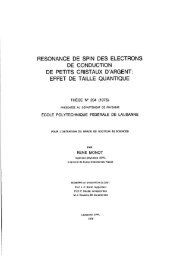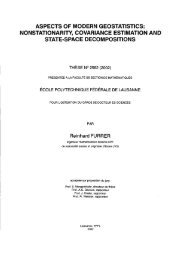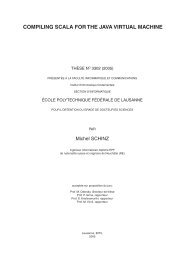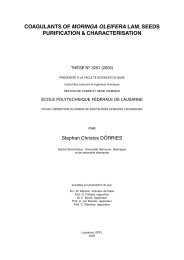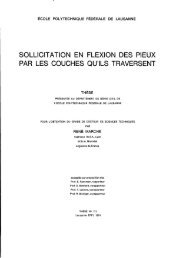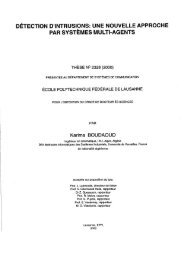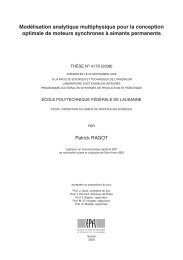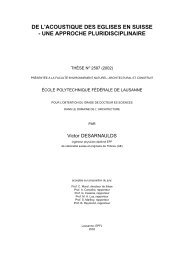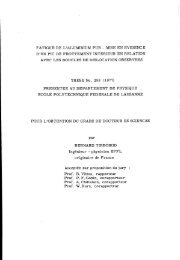Deformation and Fracture Toughness of Two-Phase Titanium ...
Deformation and Fracture Toughness of Two-Phase Titanium ...
Deformation and Fracture Toughness of Two-Phase Titanium ...
You also want an ePaper? Increase the reach of your titles
YUMPU automatically turns print PDFs into web optimized ePapers that Google loves.
<strong>Deformation</strong> <strong>and</strong> <strong>Fracture</strong> <strong>Toughness</strong> <strong>of</strong> <strong>Two</strong>-<strong>Phase</strong><br />
<strong>Titanium</strong> Aluminides<br />
THÈSE N O 4706 (2010)<br />
PRÉSENTÉE LE 4 JUIN 2010<br />
À LA FACULTÉ SCIENCES ET TECHNIQUES DE L'INGÉNIEUR<br />
LABORATOIRE DE MÉTALLURGIE MÉCANIQUE<br />
PROGRAMME DOCTORAL EN SCIENCE ET GÉNIE DES MATÉRIAUX<br />
ÉCOLE POLYTECHNIQUE FÉDÉRALE DE LAUSANNE<br />
POUR L'OBTENTION DU GRADE DE DOCTEUR ÈS SCIENCES<br />
PAR<br />
Nicolas Vincent BARBI<br />
acceptée sur proposition du jury:<br />
Pr<strong>of</strong>. J. Lemaître, président du jury<br />
Pr<strong>of</strong>. A. Mortensen, Dr F. Diologent, directeurs de thèse<br />
Pr<strong>of</strong>. F. Delannay, rapporteur<br />
Pr<strong>of</strong>. J. Giovanola, rapporteur<br />
Pr<strong>of</strong>. B. Viguier, rapporteur<br />
Suisse<br />
2010
Résumé<br />
Dans cette thèse, les propriétés en déformation et rupture d’un nouvel alliage biphasé<br />
α2 + γ Ti46Al8Ta (%at.) présentant une microstructure dite « convoluée » sont explorées.<br />
Cet alliage est produit dans le cadre du projet multipartenaire européen « IMPRESS ». Son<br />
comportement est comparé à celui d’autres alliages TiAl biphasés α2 + γ pour évaluer les<br />
performances de la microstructure convoluée dans des applications structurales critiques en<br />
contrainte et température.<br />
Des essais de compression uniaxiale comprenant des cycles de relaxation sont effectués<br />
pour des température allant de l’ambiante jusqu’à 1073 K sur trois alliages α2 + γ TiAl de<br />
composition Ti46Al avec respectivement 8Ta, 8Nb ou 7Nb (%at.). Les deux premiers sont<br />
des alliages de coulée développés pour les ailettes de turbines à gaz présentant une micro-<br />
structure convoluée. Le dernier, plus conventionnel, est un alliage forgé présentant une micro-<br />
structure duplexe. Les données comprennent la mesure de la contrainte d’écoulement et les<br />
volumes d’activation de ces trois alliages à 293, 673, 873, 923, 1023 K. Malgré les différences<br />
de composition, traitements thermomécaniques et microstructures, les valeurs recueillies et<br />
leur évolution avec la température et la contrainte sont relativement similaires pour les trois<br />
alliages. Ces similitudes, ainsi que le bon accord des résultats obtenus avec ceux présentés<br />
dans la littérature pour ce type d’alliage, mènent à conclure que l’évolution de la contrainte<br />
d’écoulement avec la vitesse de déformation est dominée par les propriétés de la phase γ<br />
et, de plus, est relativement insensible à la morphologie de la phase α2. Une anomalie dans<br />
l’évolution de la limite d’élasticité, càd une augmentation de celle-ci avec la température dans<br />
un certain domaine, est par ailleurs observée dans les deux alliages convolués.<br />
Des essais de ténacité sont effectués entre la température ambiante et 923 K sur l’alliage<br />
Ti46Al8Ta convolué et comparés à des essais sur deux alliages présentant une microstruc-<br />
ture lamellaire ; à savoir le même alliage traité thermiquement pour lui donner une structure<br />
lamellaire grossière et un alliage industriel de classe XD affiné par l’ajout de bore, de com-<br />
position Ti45Al2Mn2Nb (%at.) + 0.2 (%vol.) TiB2, également traité thermiquement pour<br />
obtenir une microstructure lamellaire. La ténacité à l’initiation (KIc) de l’alliage Ti46Al8Ta<br />
convolué varie de 12 MPa √ m à température ambiante jusqu’à 20 MPa √ m à 923 K. Ceci est<br />
comparativement un peu supérieur à l’alliage XD lamellaire, alors que l’alliage Ti46Al8Ta<br />
iii
iv<br />
avec une structure lamellaire grossière est nettement plus tenace à température ambiante. À<br />
923 K, l’alliage Ti46Al8Ta convolué est nettement meilleur que le XD lamellaire ; la ténacité<br />
de l’alliage Ti46Al8Ta présentant une microstructure lamellaire reste supérieure, dans une<br />
moindre mesure cependant. Les trois alliages testés, y.c. le convolué, montrent un comporte-<br />
ment en courbe-R marqué à température ambiante et 923 K. L’examen au microscope optique<br />
à balayage du chemin parcouru par la fissure (crack path) sur une coupe longitudinale des<br />
éprouvettes après des tests de ténacité interrompus montrent des caractéristiques de rup-<br />
ture similaires pour les trois alliages. Ces observations couplées avec les données de ténacité<br />
démontrent que l’alliage convolué étudié ici est renforcé par les même mécanismes de déflexion<br />
de fissure, micr<strong>of</strong>issuration et renfort par ligaments cisaillés que les alliages TiAl biphasé<br />
présentant une microstructure lamellaire, microstructure connue pour être optimale du point<br />
de vue de la ténacité.<br />
Les effets de la température et de l’atmosphère (vide, air sec, air atmosphérique) sont<br />
également étudiés sur l’alliage Ti46Al8Ta avec microstructure convoluée. Les données de<br />
ténacité suggèrent, entre ces trois atmosphères, une différence marginale, comprise dans l’er-<br />
reur expérimentale. Cependant, des indices de l’effet de l’humidité apparaissent durant les<br />
tests sous air atmosphérique (humide), sous forme d’avancée de fissure sous-critique que l’on<br />
présume dues à la fragilisation par l’hydrogène.<br />
Mots-clefs : Aluminure de titane ; Mécanismes de déformation ; Contrainte d’écoulement ;<br />
Ténacité à la rupture.
Abstract<br />
This thesis is an exploration <strong>of</strong> deformation <strong>and</strong> fracture properties <strong>of</strong> a novel two-phase<br />
α2 + γ Ti46Al8Ta (at.%) alloy featuring a “convoluted” microstructure, produced by partners<br />
within a European Union project named IMPRESS. Properties <strong>of</strong> this alloy are compared<br />
with those <strong>of</strong> other two-phase TiAl alloys, to assess the performance <strong>of</strong> the novel convoluted<br />
microstructure in critical, load-bearing high-temperature applications.<br />
Uniaxial compression tests featuring repeated relaxation cycles are conducted from room-<br />
temperature to 1073 K on three different α2 + γ TiAl alloys, namely Ti-46Al with 8Ta, 8Nb<br />
or 7Nb (at.%). Of these, the first two are novel “convoluted” cast titanium aluminides<br />
developed within the project, while the last is a more conventional alloy displaying a duplex<br />
microstructure. The data include measurements <strong>of</strong> the flow stress <strong>and</strong> activation volume <strong>of</strong><br />
these alloys at 293, 673, 873, 923, 1023 <strong>and</strong> 1073 K. It is found that, despite differences in<br />
composition, processing <strong>and</strong> microstructure, the values <strong>and</strong> evolution with temperature or<br />
with stress <strong>of</strong> these parameters are relatively similar for the three alloys. This observation,<br />
coupled with the agreement <strong>of</strong> present results with data in the literature for similar alloys,<br />
leads to conclude that the strain-rate dependence <strong>of</strong> plastic flow in alloys <strong>of</strong> this class is<br />
governed by features <strong>of</strong> the γ-phase that are relatively insensitive to the α2 phase morphology.<br />
The convoluted alloys furthermore feature a yield stress anomaly previously documented for<br />
this class <strong>of</strong> intermetallic alloy.<br />
<strong>Fracture</strong> toughness measurements are conducted from RT to 923 K on the Ti46Al8Ta<br />
(at.%) alloy, <strong>and</strong> compared with similar data gathered on two alloys featuring a lamellar<br />
microstructure, namely the same Ti46Al8Ta alloy heat-treated to feature a coarse lamellar<br />
structure, <strong>and</strong> a boron-refined industrial alloy <strong>of</strong> the XD class, <strong>of</strong> composition Ti45Al2Mn2Nb<br />
(at.%) + 0.2 (vol. %) TiB2, also heat-treated to display a lamellar structure. The convoluted<br />
alloy displays an initiation fracture toughness ranging from 12 MPa √ m at RT to 20 MPa √ m at<br />
923 K. Comparatively, at room temperature it slightly outperforms the fine lamellar XD alloy,<br />
while the coarse lamellar alloy <strong>of</strong> similar composition is significantly tougher. At 923 K, the<br />
convoluted alloy outperforms the fine lamellar XD alloy, the fracture toughness <strong>of</strong> the coarse<br />
lamellar is still superior but to a lesser extent. All alloys, including the convoluted alloy, show<br />
pronounced R-curve behaviour at both room temperature <strong>and</strong> 923 K. Examination <strong>of</strong> the crack<br />
v
vi<br />
path by cross-sectioning <strong>of</strong> samples having undergone interrupted toughness tests <strong>and</strong> slightly<br />
reloaded in the scanning electron microscope show roughly similar fracture characteristics for<br />
all three alloy. These observations, coupled with the fracture toughness data <strong>of</strong> this work,<br />
show that the convoluted alloy is toughened by the same mechanisms, <strong>of</strong> crack deflection,<br />
microcracking, <strong>and</strong> shear ligament toughening, as two-phase TiAl alloys having the lamellar<br />
structure, known to be optimal from the perspective <strong>of</strong> fracture toughness.<br />
The effects <strong>of</strong> temperature <strong>and</strong> atmosphere (vacuum, dry air <strong>and</strong> atmospheric air) are<br />
assessed on the Ti46Al8Ta alloy featuring a convoluted microstructure. <strong>Fracture</strong> toughness<br />
data suggest a marginal difference between dry or atmospheric air; however, the difference<br />
is within experimental error. During the tests, however, clear evidence was found to docu-<br />
ment that ambient humidity causes subcritical crack growth, presumably due to hydrogen<br />
embrittlement.<br />
ness.<br />
Keywords: <strong>Titanium</strong> aluminides; <strong>Deformation</strong> mechanisms; Yield stress; <strong>Fracture</strong> tough
Contents<br />
1 Introduction 1<br />
2 Literature review 5<br />
2.1 Introduction . . . . . . . . . . . . . . . . . . . . . . . . . . . . . . . . . . . . . 5<br />
2.2 Microstructures . . . . . . . . . . . . . . . . . . . . . . . . . . . . . . . . . . . 5<br />
2.3 Mechanical properties . . . . . . . . . . . . . . . . . . . . . . . . . . . . . . . 11<br />
2.3.1 General . . . . . . . . . . . . . . . . . . . . . . . . . . . . . . . . . . . 11<br />
2.3.2 Environment effects . . . . . . . . . . . . . . . . . . . . . . . . . . . . 13<br />
2.4 <strong>Toughness</strong> . . . . . . . . . . . . . . . . . . . . . . . . . . . . . . . . . . . . . . 14<br />
2.5 <strong>Toughness</strong> models . . . . . . . . . . . . . . . . . . . . . . . . . . . . . . . . . 16<br />
2.5.1 Ductile phase bridging . . . . . . . . . . . . . . . . . . . . . . . . . . . 16<br />
2.5.2 Small scale bridging . . . . . . . . . . . . . . . . . . . . . . . . . . . . 16<br />
2.5.3 Large scale bridging . . . . . . . . . . . . . . . . . . . . . . . . . . . . 17<br />
2.5.4 Shear ligament toughening . . . . . . . . . . . . . . . . . . . . . . . . 18<br />
2.5.5 Numerical simulations by cohesive model . . . . . . . . . . . . . . . . 19<br />
2.6 Conclusion . . . . . . . . . . . . . . . . . . . . . . . . . . . . . . . . . . . . . 20<br />
Bibliography . . . . . . . . . . . . . . . . . . . . . . . . . . . . . . . . . . . . . . . 20<br />
3 Activation Volumes 33<br />
3.1 Introduction . . . . . . . . . . . . . . . . . . . . . . . . . . . . . . . . . . . . . 33<br />
3.2 Experimental Procedures . . . . . . . . . . . . . . . . . . . . . . . . . . . . . 35<br />
3.3 Results . . . . . . . . . . . . . . . . . . . . . . . . . . . . . . . . . . . . . . . . 37<br />
3.4 Discussion . . . . . . . . . . . . . . . . . . . . . . . . . . . . . . . . . . . . . . 44<br />
3.5 Conclusion . . . . . . . . . . . . . . . . . . . . . . . . . . . . . . . . . . . . . 50<br />
3.6 Acknowledgement . . . . . . . . . . . . . . . . . . . . . . . . . . . . . . . . . . 50<br />
Bibliography . . . . . . . . . . . . . . . . . . . . . . . . . . . . . . . . . . . . . . . 50<br />
4 <strong>Fracture</strong> <strong>of</strong> Convoluted <strong>and</strong> Lamellar TiAl alloys 57<br />
4.1 Introduction . . . . . . . . . . . . . . . . . . . . . . . . . . . . . . . . . . . . . 57<br />
4.2 Experimental Procedures . . . . . . . . . . . . . . . . . . . . . . . . . . . . . 59<br />
vii
viii CONTENTS<br />
4.2.1 Materials . . . . . . . . . . . . . . . . . . . . . . . . . . . . . . . . . . 59<br />
4.2.2 Testing . . . . . . . . . . . . . . . . . . . . . . . . . . . . . . . . . . . 60<br />
4.2.3 Post-testing characterisation . . . . . . . . . . . . . . . . . . . . . . . 62<br />
4.3 Results . . . . . . . . . . . . . . . . . . . . . . . . . . . . . . . . . . . . . . . . 62<br />
4.3.1 Materials . . . . . . . . . . . . . . . . . . . . . . . . . . . . . . . . . . 62<br />
4.3.2 <strong>Fracture</strong> <strong>Toughness</strong> . . . . . . . . . . . . . . . . . . . . . . . . . . . . 64<br />
4.3.3 Fractography . . . . . . . . . . . . . . . . . . . . . . . . . . . . . . . . 66<br />
4.4 Discussion . . . . . . . . . . . . . . . . . . . . . . . . . . . . . . . . . . . . . . 68<br />
4.5 Conclusion . . . . . . . . . . . . . . . . . . . . . . . . . . . . . . . . . . . . . 80<br />
4.6 Appendix . . . . . . . . . . . . . . . . . . . . . . . . . . . . . . . . . . . . . . 81<br />
4.6.1 Crack path pr<strong>of</strong>iles . . . . . . . . . . . . . . . . . . . . . . . . . . . . . 81<br />
4.6.2 Crack path data . . . . . . . . . . . . . . . . . . . . . . . . . . . . . . 88<br />
Bibliography . . . . . . . . . . . . . . . . . . . . . . . . . . . . . . . . . . . . . . . 88<br />
5 Environmental effect 95<br />
5.1 Introduction . . . . . . . . . . . . . . . . . . . . . . . . . . . . . . . . . . . . . 95<br />
5.2 Experimental method . . . . . . . . . . . . . . . . . . . . . . . . . . . . . . . 96<br />
5.3 Results . . . . . . . . . . . . . . . . . . . . . . . . . . . . . . . . . . . . . . . . 97<br />
5.4 Conclusion . . . . . . . . . . . . . . . . . . . . . . . . . . . . . . . . . . . . . 101<br />
Bibliography . . . . . . . . . . . . . . . . . . . . . . . . . . . . . . . . . . . . . . . 101<br />
6 Conclusions <strong>and</strong> Perspectives 107<br />
6.1 Conclusions . . . . . . . . . . . . . . . . . . . . . . . . . . . . . . . . . . . . . 107<br />
6.2 Perspectives . . . . . . . . . . . . . . . . . . . . . . . . . . . . . . . . . . . . . 109<br />
A Testing Methods 111<br />
A.1 <strong>Fracture</strong> toughness testing . . . . . . . . . . . . . . . . . . . . . . . . . . . . . 111<br />
A.2 SEM in-situ observations . . . . . . . . . . . . . . . . . . . . . . . . . . . . . 118



